Table of Contents
If you own a restaurant, then you know that one of the most important pieces of equipment in your kitchen is the grease trap. Without it, your kitchen would be a grease-filled mess. But what you may not know is how to maintain your grease trap with proper maintenance. Keep reading to learn how to keep your grease trap working properly.
What are some grease trap maintenance tips?
Grease traps are a vital part of any restaurant or business that prepares food. The trap captures the grease and oils from the kitchen before entering the drainage system. This prevents blockages and backups, which can cause extensive damage to your property and create a health hazard. It’s important to properly maintain your grease trap’s functionality to continue doing its job effectively. Here are some tips on how to do just that:
- Make sure you use the right grease interceptor for your needs.
- Make sure that the grease trap is always clear of blockages. Grease and food particles will accumulate over time and can cause the trap to become clogged. If this happens, the wastewater will not be able to flow through the trap properly and will back up into your kitchen.
- Periodically check the drainage pipes leading from the trap to make sure they are clear and free of obstructions. Clogs in these pipes can cause wastewater backups as well.
- Clean the trap regularly. The frequency will depend on how often it’s used, but cleaning it every month is typically recommended. A grease trap service or qualified technician can clean your grease trap waste for you.
- Be sure to use safe and effective cleaning products, such as those for grease trap maintenance. Regularly clean out the grease trap with a degreasing agent or detergent. This will help remove accumulated oils or fats and keep the trap functioning properly.
- Inspect the seals around the lid of the grease trap for wear and tear. If they are damaged, water may seep through and cause problems with the drainage system. If necessary, replace them with new seals from your local hardware store.
- Monitor the amount of grease in the trap. If it becomes too full, it will not be able to function correctly. Remove the excess grease either by hand or with a pump as needed.
If a grease trap is not properly maintained, the fats, oils, and grease will build up and create a blockage. This will cause wastewater to back into the sink or flow onto the ground. In extreme cases, this can lead to a sewage spill.
What are some tips for reducing FOG waste in the kitchen?
One way to reduce fog waste in the kitchen is to keep the grease interceptor functioning properly. Grease interceptors are designed to capture FOG before it enters the wastewater system. If the grease trap is not maintained correctly, it can lead to increased costs for your business due to increased sewer fees and fines from regulatory agencies.
A build-up of grease and fatty acids can cause the drainage system to become slower and less efficient. Cleaning it frequently will help remove collected FOG and debris that can clog the drain pipe or catch basin to ensure your grease trap functions properly. Also, ensure food particles do not enter the grease trap. Food particles attract rodents and other pests, creating additional problems. In addition, ensure that only liquid waste enters the grease trap. Solid materials (e.g., paper towels) can clog the drain pipe or catch basin.
By following these simple guidelines, you can keep your grease trap functioning properly, prevent any unwanted sewage backups in your kitchen, and keep the wastewater system running smoothly. It’s important to keep the grease trap clean and to dispose of the grease and debris properly.

